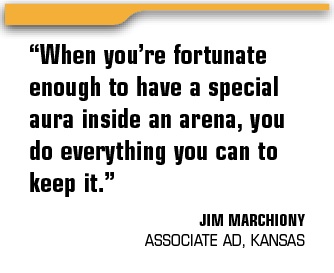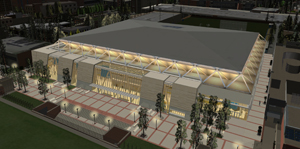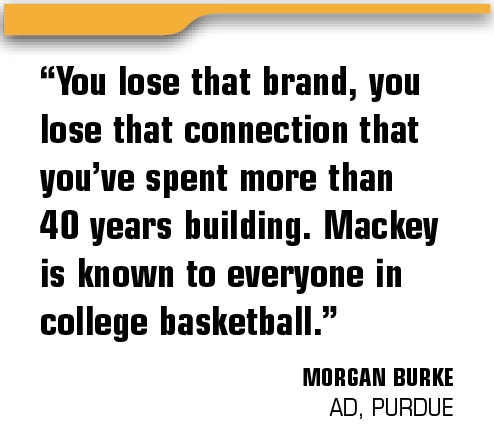UCLA Athletic Director Dan Guerrero leaned forward from his seat on the sofa as John Wooden began to speak.
In his nine-plus years at UCLA, Guerrero had been to Wooden’s modest condominium in Encino, Calif., probably a hundred times. This time, about two years ago, he sat in Wooden’s den, the same place where scores of former players and coaches had visited the legendary coach. He listened as Wooden, sitting in his recliner, talked about 1965.
It was the year Pauley Pavilion opened on UCLA’s campus and became the Bruins’ basketball home.
“Coach would never give advice or try to tell me what to do, but he always had this way of getting to a point so that I understood what he meant,” Guerrero said of Wooden, who died last year. “He said Pauley was like ‘manna from heaven’ when it was built. It was clear that if Pauley had good bones and could be saved, it would be important to Coach.”
Guerrero had gone to Wooden’s condo to talk about an issue that many athletic directors with historically strong basketball programs have faced: How do you protect a basketball shrine while offering the kind of modern amenities that produce more revenue and keep the big donors happy — and generous?
UCLA is in the midst of a $136 million renovation to Pauley Pavilion, a path Guerrero pursued — with Wooden’s blessing — in the face of strong sentiment to build a new arena. Other schools are dealing with similar issues on their campuses as they try to preserve iconic arenas.
Purdue is spending $100 million to upgrade and enhance Mackey Arena, which was built two years after Pauley. Again, Purdue elected to renovate the old hall rather than build new.
Butler just announced plans to spend $25 million on fabled Hinkle Fieldhouse, which opened in 1928 and was the site
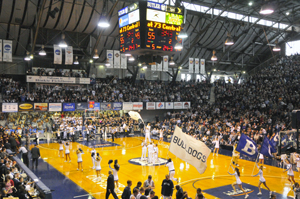 |
Butler's Hinkle Fieldhouse will undergo $25 million in renovations.
Photo by: JOHN FETCHO / BUTLER UNIVERSITY |
where the movie “Hoosiers” was filmed.
And Duke is about to embark on a multimillion-dollar project to improve the look and the moneymaking potential of Cameron Indoor Stadium’s 71-year-old exterior, while leaving its unique interior untouched.
Not every school has decided to protect the longtime home court. Louisville abandoned Freedom Hall to move into a new downtown arena that was built in partnership with the city. Down I-64 in Lexington, a 45-person panel is debating whether to renovate Kentucky’s well-known, history-filled home, 35-year-old Rupp Arena, or build a new downtown facility, again in tandem with the city.
“When you’re fortunate enough to have a special aura inside an arena, you do everything you can to keep it,” said Jim Marchiony, associate AD at Kansas, which is home to 56-year-old Allen Fieldhouse. “You don’t start sacrificing the history and tradition that you’ve worked so long to build.”
Guerrero’s outreach to Wooden shows the delicacy involved with making changes to venerable buildings at tradition-rich
basketball schools.
It’s what led Duke AD Kevin White to sternly respond, “Not on my watch,” when asked if Cameron’s interior might benefit from an update.
It’s what prompted Butler AD Barry Collier to say, “Over my dead body” will Hinkle see an overhaul.
That’s the kind of passion those arenas generate among their faithful.
“There’s a real sentimental quality to these older buildings,” said Gary Sparks, an Oklahoma State alumnus whose architectural firm designed the renovations to OSU’s Gallagher-Iba Arena. “My first date with my wife of 45 years was in that arena. So was our second date. When you have a building like that, it’s a sacred cow and you don’t mess with the sacred cow.”
But in difficult economic times, when ADs are turning over every rock in the search for more funding, the basketball arena provides an important revenue stream.
The need to preserve traditional college basketball environments while also driving revenue from premium seating and club areas is one of the chief balancing acts that administrators face.
Here are a few approaches that schools around the country are taking:
Pauley Pavilion didn’t need only a fresh coat of paint. Guerrero described Pauley’s condition as draconian. One of his first challenges was to determine if the old building “had good bones.” In other words, was the foundation and the easily identifiable exterior strong enough to keep in place, while upgrading the interior.
“It had mechanical issues, it had plumbing issues,” he said. “It was the kind of thing that couldn’t just be fixed. We had to do something pretty major. We knew that there was a sensitivity to the facility itself, knowing that it’s an iconic venue, but we also understood that we might need to build a new arena.”
On top of the infrastructure needs, Guerrero faced the pressure coming from the other side of Los Angeles, where rival Southern California had recently built a sparkling new arena.
But as Guerrero talked to Wooden and the grandsons of Edwin Pauley, the primary individual donor for the original building, it became clear that retaining Pauley’s charm, including its distinctive trellises and white roof, needed to be the priority.
Los Angeles-based design firm NBBJ is driving
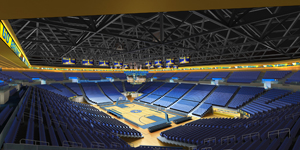 |
UCLA’s $136 million facelift to Pauley Pavilion includes modern elements such as an LED ribbon board in the seating bowl.
Photos courtesy of UCLA |
the project, which will create new concourse and lobby space, including room that will showcase UCLA’s storied basketball past.
UCLA is working with another local firm, EMG, to find a corporate naming-rights partner, as well as secondary partnerships that could end up being cornerstone sponsors.
The expanded concourse and lobby, a new LED ribbon board and a new scoreboard also will present selling opportunities for UCLA’s multimedia rights partner, IMG College.
“We also talked long and hard about suites and premium seating, but in the end, we decided we wanted this facility to maintain its college feel,” Guerrero said. “We wanted to retain as much of the original feel at Pauley as we could.”
The Bruins have brought in about $70 million of the $100 million they’re seeking in private donations. Student fees will account for another $15 million and most of the balance will be borrowed.
Donations of up to $3,200 for midcourt seats will be attached to each ticket. Some season-ticket holders had to be moved out of choice seats if they didn’t pay the associated donation.
“Some people have been in those seats since the building opened, so a decision had to be made, and those conversations have been challenging at times,” said Mark Harlan, UCLA’s senior associate AD for external operations.
By the time the project is done — UCLA will play at the Los Angeles Sports Arena this season — the Bruins expect to see $5 million to $7 million in new revenue from Pauley Pavilion.
“People will walk in and see that it’s still Pauley, and that was very important to the process,” Harlan said. “And we’ll still have all of the stuff you need in this day and age.”
The original master plans from designer HNTB called for cosmetic changes to initially freshen up Mackey Arena. And then in 2025, the old gym would come down, to be replaced by a sparkling new arena about seven miles off the West Lafayette, Ind., campus.
“When they started talking about imploding Mackey Arena in 2025, that just didn’t sit well with me,” Purdue AD Morgan Burke said. “You lose that brand, you lose that connection that you’ve spent more than 40 years building. Mackey is known to everyone in college basketball. Also, we couldn’t afford it.”
Instead, the Boilermakers went with a renovation of Mackey that left the building intact with a $100 million upgrade, a fraction of what the school could have spent building a new arena.
Purdue is reintroducing the new and improved Mackey Arena to Boilermakers fans this week through a series of open houses.
About a third of the price tag is being raised through donations. The rest of the debt will be paid off through future revenue tied to the arena’s premium seating and growing Big Ten Network revenue.
Kansas City-based HNTB is the architect, while Turner Construction of Indianapolis is construction manager.
“We feel confident that the revenue stream is secure,” Burke said.
Purdue is selling Spurgeon Club season passes for $2,500, providing access to a high-end club where fans can enjoy
 |
Purdue spent $100 million on enhancements and additions to Mackey Arena.
Photo by:TURNER CONSTRUCTION |
dinner and drinks. The West Club, at $1,000 for a season pass, will offer more of a sports-bar feel. Food and beverage in each club sell a la carte and the season passes are on top of the fee for season tickets.
Purdue will have about 525 club seats and about 75 Wooden Courtside Club seats.
Introducing new fees and some seat reassignments has been painful at times, but it’s all part of keeping Mackey viable and vibrant at a time when the old building needed a makeover.
“There’s just an affinity that people have, not unlike the way Green Bay feels about Lambeau Field,” Burke said.
“Lambeau is a shrine, or as close as you can get. Most of the people who buy tickets to Purdue basketball grew up in that arena. A lot of our donors were in school at the time when Mackey was built in the 1960s. They see it as a piece of history that needs to be preserved.”
Collier remembers the first time he walked through Hinkle Fieldhouse in 1974 “like it was yesterday.” A junior college basketball recruit from Miami, Collier describes walking through Hinkle as “my Hoosier moment” as he strode through the classic fieldhouse with the barrel roof, windows at each end, and 820,000 bricks on the exterior that provide charm in abundance.
“Not a day goes by that we don’t have visitors walking through Hinkle,” said Collier, who coached at Butler and Nebraska before returning to his Indianapolis alma mater in 2006 to take the AD’s job. “It’s like a pilgrimage for a lot of people.”
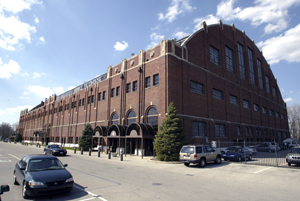 |
Butler will actually reduce the size of sponsor signs inside Hinkle Fieldhouse.
Photo by: BRENT SMITH/BUTLER UNIVERSITY |
Collier, the caretaker of the building that’s registered as a national historic landmark, is resisting the temptation to modernize the distinctive facility. Instead, Butler is going the other way. The Bulldogs are planning to restore and preserve as much as renovate.
About $25 million — privately financed through donations — is being spent to upgrade the inner workings of the building, add more chair-back seats, install a new scoreboard and — get this — actually condense signage to restore it to its unobtrusive look from the 1930s and ’40s.
Collier and the design team from Aecom researched old photos from more than 70 years ago, including a series of photos from when Jesse Owens competed in the Butler Relays in the 1930s.
From those photos, Butler decided to replicate the smaller and fewer number of signs in the fieldhouse. How that affects revenue remains to be seen. Butler handles its own multimedia and marketing rights in-house.
Hinkle will see an upgrade in the seating. About a third of the arena’s seats have seatbacks now and that number will grow to two-thirds as part of this project. The new seats will drop capacity from 10,000 to 8,500.
As for the new scoreboard with video, “It’s not going to look like a ship from outer space hovering over the court,” Collier said. “It’s got to fit.”
There’s not a tangible revenue benefit, at least not right away, although ticket prices could be expected to increase for the new chair-back seats. Donations can be made to upgrade seat locations in Hinkle, but they are not required to buy season tickets.
“We think there will be some revenue impact,” Collier said. “We’re going to have more comfortable seating, we’ll be better able to respond to ADA requests, and we’re providing a better experience for our fans in the concourse and concession areas. We think ultimately that will result in more demand for tickets.”
The cozy confines of Cameron Indoor Stadium make for perhaps the most intense and unique environment in college basketball.
But with just more than 9,000 seats and no suites, Duke is limited in its ability to increase Cameron-related revenue without making significant overhauls to the inner bowl.
That’s led the Blue Devil administration to look outside of the building’s main arena for opportunities related to
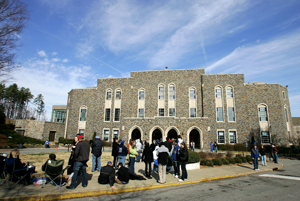 |
Duke is looking at the possibility of attaching hospitality areas to Cameron Indoor Stadium.
Photo by: GETTY IMAGES |
hospitality, clubs and merchandise sales.
Unlike the projects at Butler, Purdue and UCLA, Duke has not designated a price tag or a strict timeline for a Cameron upgrade, and the administration is keeping plans close to the vest.
One element that seems to have potential is the addition of hospitality areas attached to Cameron that would also serve as a club area for nearby Wallace Wade Stadium during football season. Schools such as Auburn and Oklahoma State have found the dual use of suites and clubs for football and basketball to be an efficient and profitable use of the space.
But like many of his peers, Duke’s White vows not to do anything that would detract from Cameron’s unique atmosphere.
As Butler’s Collier said, “Bigger isn’t necessarily better. Better is better. We all have values we need to protect and we better know where to draw the line.”


